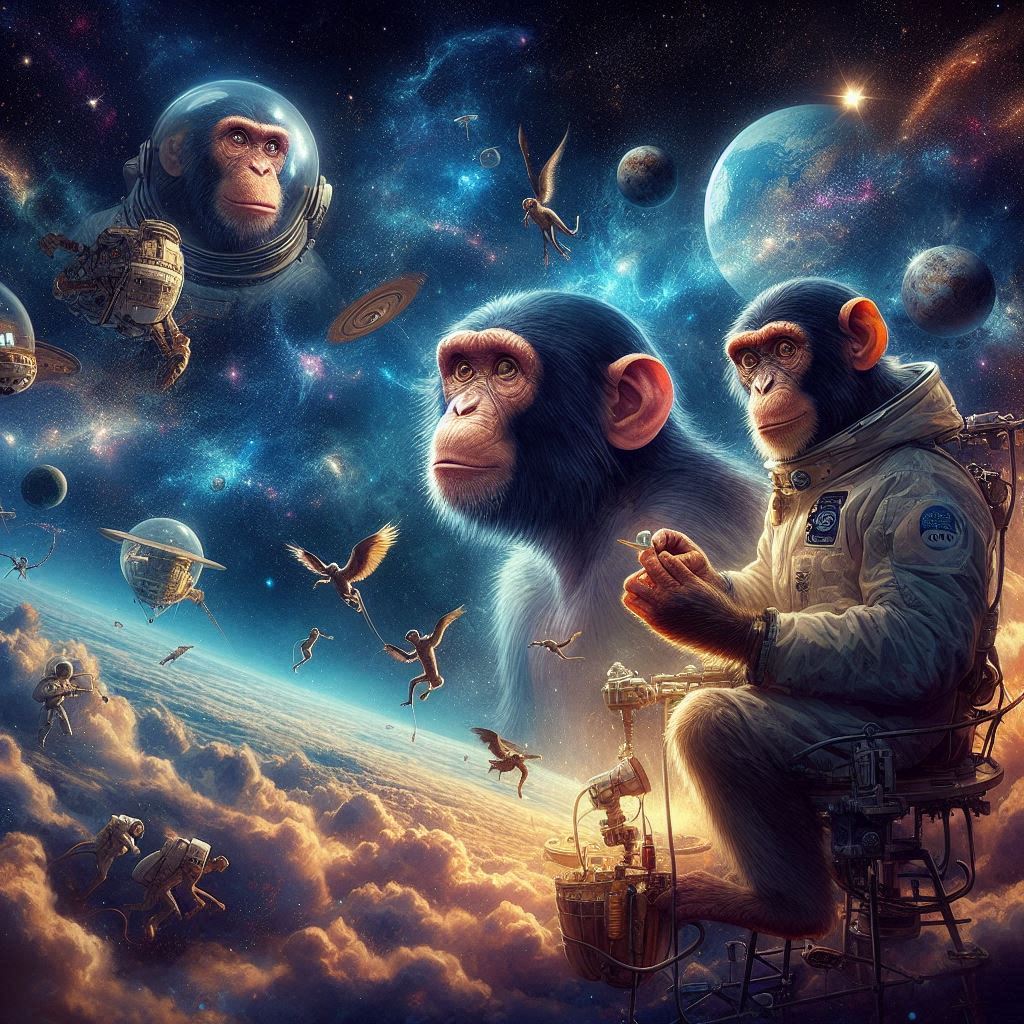
Monkeys in Space: The Primates That Helped Humans Explore the Stars
Share
Monkeys in Space: The Primates That Helped Humans Explore the Stars
Monkeys, along with other animals, have played pivotal roles in the history of space exploration. In the early days of space travel, scientists turned to primates to test the effects of space travel on living organisms before sending humans into the unknown. Monkeys’ physical and biological similarities to humans made them the ideal candidates for this important, albeit controversial, work. Let’s take a journey through history and look at some of the brave primates who helped humanity explore the stars.
1. The Early Pioneers: Monkey Flights Before Humans
In the 1950s and early 1960s, space agencies were just beginning to push the boundaries of space travel. Before astronauts could board spacecraft, it was necessary to conduct experiments to determine how living beings would react to the conditions of space—namely weightlessness, radiation, and the physical stresses of launch and reentry. Monkeys, being similar to humans in terms of their cardiovascular and nervous systems, were used as test subjects for these early missions.
One of the first monkeys to take part in a spaceflight was Albert I, a rhesus macaque launched by the U.S. in 1948. Unfortunately, Albert I did not survive the flight, as the rocket failed during ascent. However, his mission was crucial in proving the concept of sending living beings into space. Despite the tragic outcome, Albert I paved the way for future primates to go further.
2. The Famous “Space Monkeys”: Able and Baker
Perhaps the most famous of space monkeys were Able and Baker, who were sent on a groundbreaking flight in 1959 by NASA. Able was a rhesus macaque, and Baker was a squirrel monkey. These two primates were part of a mission that tested the effects of space travel on living organisms.
Able and Baker’s flight lasted just 16 minutes but was a critical success. They were launched aboard a Jupiter AM-18 rocket, and both monkeys survived the journey, which included a brief period of weightlessness, acceleration, and reentry. Their success marked an important milestone for space exploration, demonstrating that living creatures could survive spaceflight and the intense conditions of space.
After their return to Earth, Able sadly passed away due to complications from anesthesia during a routine medical procedure, but Baker lived for many years afterward, even becoming a beloved mascot for NASA. Their successful mission helped build confidence for the eventual human space flights that would follow.
3. The Soviet Union’s Contributions: Laika and Beyond
While the United States was sending monkeys into space, the Soviet Union was not far behind in their own animal space program. One of the most famous Soviet animals to be sent into space was Laika, a stray dog who became the first living being to orbit Earth in 1957 aboard Sputnik 2. While Laika was a dog, the Soviet Union also conducted experiments with monkeys, including Shum and Masha, who were launched aboard a spacecraft in the early 1960s.
These Soviet monkeys, though not as widely remembered as Able and Baker, were integral in helping the USSR test the effects of space travel on biological organisms. The tests done on these primates helped further the understanding of the physical challenges of space and contributed to the eventual success of manned space missions.
4. The 1960s: More Monkeys, More Flights
The 1960s saw a continued interest in using primates for space research, particularly as the U.S. and the Soviet Union prepared for human space exploration. The U.S. conducted several missions with monkeys during this time. One notable mission involved Ham, a chimpanzee who was trained to operate a spacecraft’s controls.
On January 31, 1961, Ham was launched into space aboard Mercury-Redstone 2. Unlike the earlier missions, Ham’s flight wasn’t just a passive test of survival; he was trained to perform tasks during the flight, such as pushing buttons when he saw certain lights. His ability to perform these tasks proved crucial for human spaceflight, demonstrating that astronauts could work effectively under space conditions. After a 16-minute flight, Ham returned safely to Earth, and his success was a major milestone in the development of the U.S. space program.
5. The Space Chimps: Gordo, Enos, and Others
In addition to Ham, the space program also relied on other chimpanzees, such as Gordo and Enos, to test the viability of human space travel. Enos, another chimpanzee, was sent into orbit in 1961 aboard Mercury-Atlas 5, where he became the first chimp to orbit the Earth. His mission lasted over three hours and involved several complex tasks, including operating spacecraft controls.
Although the missions involving primates were often fraught with risks, they contributed valuable data that informed later human flights, particularly regarding the physical and psychological effects of space travel on living beings. Enos’ successful mission paved the way for human astronauts to follow, and his journey was one of the many early steps toward the eventual landing on the Moon.
6. The Ethics of Using Monkeys in Space
While the space missions involving monkeys helped make incredible strides in human space exploration, they were also controversial due to ethical concerns. Animal rights groups and many in the scientific community began to question the morality of sending primates into space, given the risks and stresses the animals endured.
The 1980s saw a shift in attitudes toward animal testing, particularly when it came to space exploration. By then, animal testing had given way to more advanced technology, such as computer simulations and robotic systems, which allowed space agencies to continue their research without needing to send live animals into space.
7. Monkeys and Space Research Today
Although monkeys are no longer used in space missions, their contributions to the space program are still remembered today. Space agencies now use more advanced technology and human-like robots to conduct experiments in space. However, the legacy of the primates that helped test the conditions of space travel remains an important chapter in the history of space exploration.
Monkeys in space were pioneers of a different sort—small but mighty, they played a key role in humanity’s understanding of space. Their bravery and contributions helped shape the future of space exploration, paving the way for human space travelers to venture farther than ever before. Today, their stories live on as a testament to the incredible risks and sacrifices that were made in the early days of space exploration.
CyberMutz.com (Dog-Themed Apparel & Accessories)
“CyberMutz.com – Explore a unique collection of dog-themed apparel, accessories, and gifts for pet lovers. Shop stylish, high-quality designs featuring your favorite dog breeds!” Category Page Descriptions: Dog Breed T-Shirts: “Show off your love for dogs with our exclusive breed-themed T-shirts. From German Shepherds to Chihuahuas, find high-quality, comfortable tees celebrating your favorite pup!” Dog Breed Pet Tank Tops: “Keep your furry friend stylish and comfortable with our dog breed-themed pet tank tops. Perfect for small and large dogs, these unique designs are a must-have!” Funny Dog-Themed Apparel: “Love dogs and humor? Our funny dog-themed apparel blends style with witty canine-inspired designs. Shop now for T-shirts, hoodies, and more!” Personalized Dog Merchandise: “Customize your dog lover’s gear with our personalized pet-themed apparel and accessories. Create a one-of-a-kind look for yourself or a perfect gift for a fellow dog enthusiast!”
CyberPussyKatz.com (Cat-Themed Apparel & Accessories)
“CyberPussyKatz.com – Celebrate your love for cats with our premium collection of feline-inspired apparel and accessories. Purr-fect designs for every cat lover!” Category Page Descriptions: Cat Breed T-Shirts: “Showcase your favorite feline friend with our stylish cat breed-themed T-shirts. From Maine Coons to Siamese, find the perfect tee for cat lovers!” Funny Cat-Themed Apparel: “Express your quirky side with our funny cat-themed T-shirts, hoodies, and more. Pawsome designs for those who love cats and humor!” Personalized Cat Merchandise: “Make it personal with custom cat-themed apparel and accessories. Create a unique gift or a special piece just for you!”
CyberMunkiez.com (Monkey-Themed Apparel & Accessories)
“CyberMunkiez.com – A fun collection of monkey-inspired apparel and accessories. Perfect for primate lovers who enjoy bold, playful, and unique designs!” Category Page Descriptions: Monkey-Themed T-Shirts: “Go bananas over our monkey-themed T-shirts! Whether you love capuchins, chimps, or gorillas, our designs bring out your wild side.” Funny Primate Apparel: “Add a touch of humor to your wardrobe with our hilarious monkey and ape-inspired apparel. Great for animal lovers and jungle enthusiasts!” Custom Monkey Merchandise: “Make it yours! Personalize your favorite monkey designs on T-shirts, hoodies, and more for a one-of-a-kind look.”
